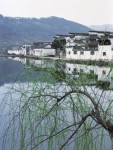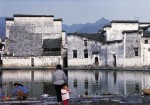Huizhou in Hills and Waters-Hongcun A Village of Rivers and Lakes
Huizhou are seized of green hills and clear waters, where the landscape is like a picture. The Huizhou dwellings adapted to the characters of hills and waters there and gave full play to them. The villages at Huizhou paid much attention to integrated planning, selecting location skillfully, geomantic omen and perfect structure. The buildings at Huizhou were usually located in the shade but faced to the sun, situated at the foot of a hill for using the water sufficiently and suiting measures to local conditions – if on plains, concentrated on a place and if not on plains, distributed dispersedly. The model of these villages is Hongcun, a village of rivers and waters, one of the world cultural heritages.
a picture. The Huizhou dwellings adapted to the characters of hills and waters there and gave full play to them. The villages at Huizhou paid much attention to integrated planning, selecting location skillfully, geomantic omen and perfect structure. The buildings at Huizhou were usually located in the shade but faced to the sun, situated at the foot of a hill for using the water sufficiently and suiting measures to local conditions – if on plains, concentrated on a place and if not on plains, distributed dispersedly. The model of these villages is Hongcun, a village of rivers and waters, one of the world cultural heritages.
Hongcun is located at the north of Yixian, northward against Leigang Hill and southward to the Yangjian River. This position is just required by geomantic omen: “to be located in the shade but to face to the sun” and “with hills behind and water in front”. The most distinguishing feature of Hongcun is artificial water channels distributed all over the village.
Hongcun began to be set up in the first year of the Shaoxing period of the Southern Song Dynasty (1131), but the construction of channels on a large scale began in the early Ming Dynasty. At that time, the villagers introduced the streamlets into the village, and dug channels with a length of over 300 meters, which flowed through the yards of every household at the village, and finally converged on a pond like a crescent moon in the front of the clan ancestral hall, built at the center of the village. 150 years afterward, the villagers opened a large pond – South Lake with a superficies of over 100 mu at the south of the village. In the 400 years from then on, this perfect structure of channels has been still reserved by Hongcun villagers and used by them in their ordinary life. The entrance of the channel system is situated at a relatively high land, where the villagers built a dam with stone and installed a water gate to raise the water level. The water gate is the entrance of channels as well as the head of the channel system.
The general channels are 60 cm wide and 1 m deep, crossing circuitously through the lanes of the village, from the northwest to the southeast extending in all directions. A poet in the Ming Dynasty described: “In every dooryard flows a limpid streamlet”. Lastly, all channels rush down into the village’s center – the Moon Pond, whose north part is straight and south curved, like a new moon. Like a blood circulation system, the channel system stimulates the spiritual and material life of the village. On the one  hand, the channel system plays a role of washing, fire protection, drainage and adjustment of temperature and humidity; on the other hand, together with the flagging, gardens and yards, squares and arches over gateway, it has become a changeable sight with distinguishing features and a public place for villagers’ rest and social intercourse. Walking at Hongcun, we can see loquacious waters reflect mottle white walls and black tiles, green hills and blue sky; simple and unsophisticated flagging connect profound courtyards, pavilions, terraces and open halls. In the South Lake at the south of village, we can see osier willows in spring, lotus flowers in summer, red leaves in autumn and white snow in winter – the sight in each season gives full play to its strong points. The channels not only link every house but also are introduced into the dooryard to form a small pond with its own feature. The water brings natural spirit to every house.
hand, the channel system plays a role of washing, fire protection, drainage and adjustment of temperature and humidity; on the other hand, together with the flagging, gardens and yards, squares and arches over gateway, it has become a changeable sight with distinguishing features and a public place for villagers’ rest and social intercourse. Walking at Hongcun, we can see loquacious waters reflect mottle white walls and black tiles, green hills and blue sky; simple and unsophisticated flagging connect profound courtyards, pavilions, terraces and open halls. In the South Lake at the south of village, we can see osier willows in spring, lotus flowers in summer, red leaves in autumn and white snow in winter – the sight in each season gives full play to its strong points. The channels not only link every house but also are introduced into the dooryard to form a small pond with its own feature. The water brings natural spirit to every house.
Water gate – channels – the Moon Pond – the South Lake, together with the small pond at every yard, compose an integrated water system and become the spirit of the village. The waters and hills, the streets, the lanes and the buildings, as well as villagers’ life and culture form an integrated organism. The enlightenment from them is that the human beings can co-exist harmoniously with nature, utilize and protect the nature; nature is not only the object of human being’s use and transformation, but also an indiscerptible part of human being’s ordinary life.